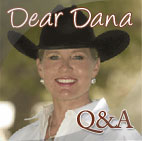Top 10 Tips to get into the Rose Parade
 PASADENA — For many equestrians, one of the highlights of New Year’s Day is watching the Tournament of Roses Parade–and the equestrian groups which take part in the world-famous parade seen by millions of people every year.
PASADENA — For many equestrians, one of the highlights of New Year’s Day is watching the Tournament of Roses Parade–and the equestrian groups which take part in the world-famous parade seen by millions of people every year.
The Rose Parade is shown in more than 75 countries, and nearly 1 million spectators line the 5.5-mile parade route. Jon Montgomery, equestrian committee chairman of the Tournament of Roses Parade, shared some suggestions on how to improve your chances of getting into the parade.
For any equestrian group who has ever wanted to take part in the Rose Parade, here are tips to keep in mind.
Rose Parade dreams come true for California Arabian group
Region One Versatile Arabians successfully ride in the Tournament of Roses Parade as a first-time entry

Members of the Region One Versatile Arabians achieve their goal of riding in the 2010 Rose Parade.
Every New Year’s Day since she was a girl, Molly Jenks of Norco has raced to the television to watch the elaborate floats and equestrian groups in Pasadena’s Tournament of Roses Parade. So when Jenks learned in July 2009 that she and Rocky, her 21-year-old Arabian horse, had been accepted to participate in the 2010 New Year’s Day parade that she has idolized since childhood, it came as a shock. At her Norco ranch, Jenks, 37, explained how excited she was for her champion horse to walk in the world-famous parade among other first-rate equestrian groups.
USEF honors California riders, horses as finalists for top, year-end awards
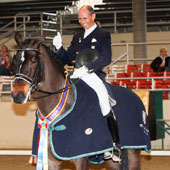
Steffen Peters, of San Diego, and Ravel, owned by Akiko Yamazaki, are nominated for 2009 USEF Equestrian-and-Horse of the Year awards.
There are five Horses of Honor nominated for 2009 USEF Horse of the Year. The California-owned horses are Kripton-Seni II, a 9-year-old bay Andalusian stallion owned by Joe and Nancy Latta of Amandalusian Farm in Burbank, Calif.; and Ravel, an 11-year-old bay Dutch Warmblood gelding owned by Akiko Yamazaki of Los Altos, Calif.
The other nominees are: Courage to Lead, a 12-year-old bay Morgan mare owned by Beverley Lesher; CH Our Charming Lady, an 8-year-old bay American Saddlebred mare owned by Jack and Donna Finch; and Sapphire, a 14-year-old chestnut Belgian Warmblood mare owned by McLain Ward and Bluechip Bloodstock.
Californian Richard Neal wins Emerging Athlete honor
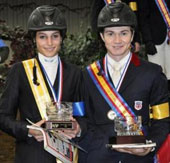
Carly Anthony and Richard Neal earn honors from the U.S. Hunter Jumper Association's Emerging Athletes Program.
“It is an honor, and I feel very privileged to be chosen as one of the two winners. I am extremely happy for Ricky,” Anthony said. “He deserved it and I am very proud of the rest of my peers for riding as hard as they can and being the best horsemen they can as well.”
Neal shared her excitement and said: “To be chosen from a group of riders of this quality is really an honor, so I feel pretty fantastic.”
Tony Piggott takes ‘Rockin’ win at NCHA Futurity Open
Owned Alice Walton’s Rocking W Ranch, Rockin W–a stallion by Dual Rey out of Walton’s former NCHA Horse of the Year Boon San Kitty–is a two-time winner of the NCHA Classic Challenge, and an earner of more than $498,000.
The 23-day event from Nov. 21-Dec. 13, 2009 included more than 1,800 entries who sought after a share of the $4 million purse.
Six of the 28 Futurity Open finalists scored more than 220 points, but it was the duo of Tony Piggott and Rockin W who claimed the prestigious NCHA Futurity Championship and the winner’s check of $250,000.
First Step: Training Your Hands
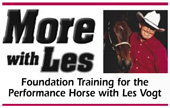 Responsive Hands Create a Responsive Mouth
Responsive Hands Create a Responsive Mouth
Have you ever ridden a horse that was so responsive to the reins, it could have been made from silk threads and never broken? If you follow the basic strategies I’m going to lay out, you should be able to create that level of responsiveness in your horse with time and practice.
So where do you start? With yourself! Until you’re trained, how do you think you could train a horse?
What exactly is ‘on the bit’?
HEY RAY!: Over the years, several of my teachers and trainers have touched on the topic of connec-tion in regards to collec-tion. They have inter-changed words such as “on the bit,” “on the vertical,” “suspen-sion,” “elevation” and “engage-ment,” in order to explain connec-tion.
But everyone seems to have a different “explana-tion”. What exactly is on the bit? Is there a difference between “on the bit” and “on the vertical”? Also, What is the true value of connec-tion and stretching and how does it influence engagement in the movement of the horse?
— Celie Weston, Tujunga, Calif.
HEY CELIE: My first challenge in answering you is to recognize the fundamental importance of the many questions you have asked — 13 QUESTIONS! Secondly, I must be clear and precise so this week’s column doesn‘t turn into a book! Clearly, you have a serious interest in dressage. What I am about to share with you, though, can be directly applied to all horses and horsemen alike, regardless of discipline.
First, let’s review some of the terms you have mentioned:
“Connection” is the moment a horse chooses to accept contact, with the intention to interact without resistance or evasion. (For example, when a loose horse looks to follow you around, when a horse accepts the attachment of a lead or lunge lin, or when your horse accepts the feel of your hands in his mouth through the bit and reins.)
“Collection” is the process of gathering up and shortening the outline or frame of the horse. This happens when the withers, neck and pole are raised in relation to the hind quarters, causing the stride to become shorter and higher. This occurs naturally by the horse, or influenced by the rider.
“Stretching” is what a horse does with his head, neck, and body in order to lengthen his outline resulting in a more forward, lower and longer frame and/or stride. (Nose on the ground).
“On the bit” is a commitment on the part of the horse, to “stretch” down into any length of rein at any given time, in lightness (self-carriage), while maintaining “Connection“. (Different than “On The Vertical”).
“On the vertical” is simply a head position. The horse’s forehead is straight up and down (vertical) or perpendicular to the ground but not necessarily on the bit. (Also known as “false head set” if not on the bit.) Note: A horse can be “on the bit” and also simultaneously on, above, or behind the vertical. On the bit while on the vertical is ideal.
“Suspension” is simply hang time. The moment the horse spends in the air during a stride when all four feet are off the ground (floating).
“Elevation” refers to how high a knee and or foot comes off the ground. It is possible to have elevation without suspension (gaited horses).
“Engagement” is what a horse does with his body in order to propel himself forward. This happens when he lowers his hindquarters and brings his back feet forward before pushing off into motion.
The moment we choose to use an artificial aid for communication, certain things need to happen if we expect the process to work. It doesn’t matter whether the artificial aid is your cell phone or a bit and bridle. Both horse and human need to recognize the aid is a tool to communicate through.
Squeezing the horse into the bit is the same as placing a call. When the horse feels the sensation, it’s the same as the receiver of the call hearing the phone ring. When the horse accepts the CONNECTION of the bit, it’s the same as when the person you are calling, decides to answer the phone. When the horse is STRETCHING down into whatever length of rein you’ve given him and stays committed to that connection, it’s the same as when the person you are calling, picks up the phone and answers it.
The continuous interest to check and see if someone is still there on the other end, is called ON THE BIT. (“On the bit” = “Are you still there?”.)
The true value of connection and stretching begins with getting the horse’s mind focused. It allows you to be able to check and see if the horse is on the bit by simply bringing your hands forward. If the horse takes up the slack (seeks the bit),it means he’s still on the bit. Another advantage is, it engages the muscles of the top line. Being able to gather or lengthen the frame of your horse through stretching also means being able to collect or extend his stride — which requires your horse to be engaged in his effort to move forward.
Celie, I hope this clarifies things for you.
Always trust your instincts and stay safe,
Ray
Horsetrader columnist Ray Ariss, husband to Pippa Ariss and father of six, shares his insight into the relationship of horseand human twice each month, in print and on www.horsetrader.com. He lives and trains in “Horsetown USA”, Norco, Calif., at his bustling Starbrite Riding Academy, where he currently has 50 horses in various stages of training, including Andalusians, Friesians, Quarter Horses, Paints, Thoroughbreds, Arabs, Mustangs and more. Ray attributes his training success to the support of his wife and partner, Pippa, and a system he calls S.W.A.P., to which he credits his multiple championships in several disciplines. His passionate understanding of the “human-horse” relationship was evident when he took on the challenge of training a wild Mustang and — in just 100 days — produced the highest-priced adopted Mustang ever — $50,000. Does your “horse-human relationship” leave you with a question for Ray? Click here to submit one!
Dear Dana: Are there precautions to take when inviting a stranger to ride a horse for sale?
DEAR DANA: What types of precautions should we take as far as liability when we have a horse for sale and invite a stranger to come try her out? It just seems like a recipe for potential problems.
–Caroline, La Jolla, Calif.
DEAR CAROLINE: What a great question you have asked, and you are so right — it is an open door for a potential problem. I want to emphasize that I am not an attorney or an expert in insurance, but I can tell you what I do when I have potential buyers come to look for a horse and hopefully this will help you to protect yourself.
First, you want to check your homeowner’s insurance policy. Typically, these do not cover horse-related activities, but some do. If yours does not, you will want to purchase a “Personal Horse Owners Policy.” This will cover you if your horse injures someone. Keep in mind that if your horse operation is a business, this will not cover you. Check into this before you purchase, as even a part-time vendor could be considered a business. Also make sure that the policy allows someone other than you and your immediate family to be covered if there is an injury. Then, whenever someone comes to your property to ride, you will need to have them sign a release of liability. You can either purchase these or download them from the internet. Make sure that your Release of Liability is compliant with your state laws, as each state is different.
Next, it is important to get to know the person. When I have a potential buyer come to look at a horse, I really quiz them. I try to determine if they are a serious buyer and if they really intend to come try out my horse. Once we set a date, I will do a check-up call to confirm that they are still coming and ask them to let me know in advance if they intend to cancel. Before you even let them ride, make sure that you feel the rider is suited for the horse.
Last but not least, you have to know your horse. How well-trained is your horse? How safe is he? Is he safe for a beginner rider? These are questions that you want to ask yourself before putting someone that you don’t know on his back. Remember, you don’t have to let them do anything that you are not comfortable with them doing!
I hope that helps! Good luck to you.
Dana
Have your own question for Dana? If so, click here! If your question is used in “Dear Dana”, you will be entered into a monthly drawing for a FREE “Winning Strides” DVD!
Sign up for Dana’s newsletter and keep up with Dana’s updates, new products and clinic schedule! When you register, you are automatically entered into a quarterly raffle for great prizes, including a FREE personal training session with Dana! Click here to sign up now!


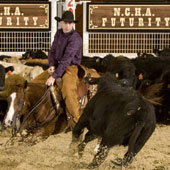
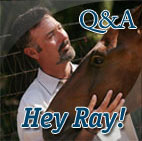
 Read Columns
Read Columns
